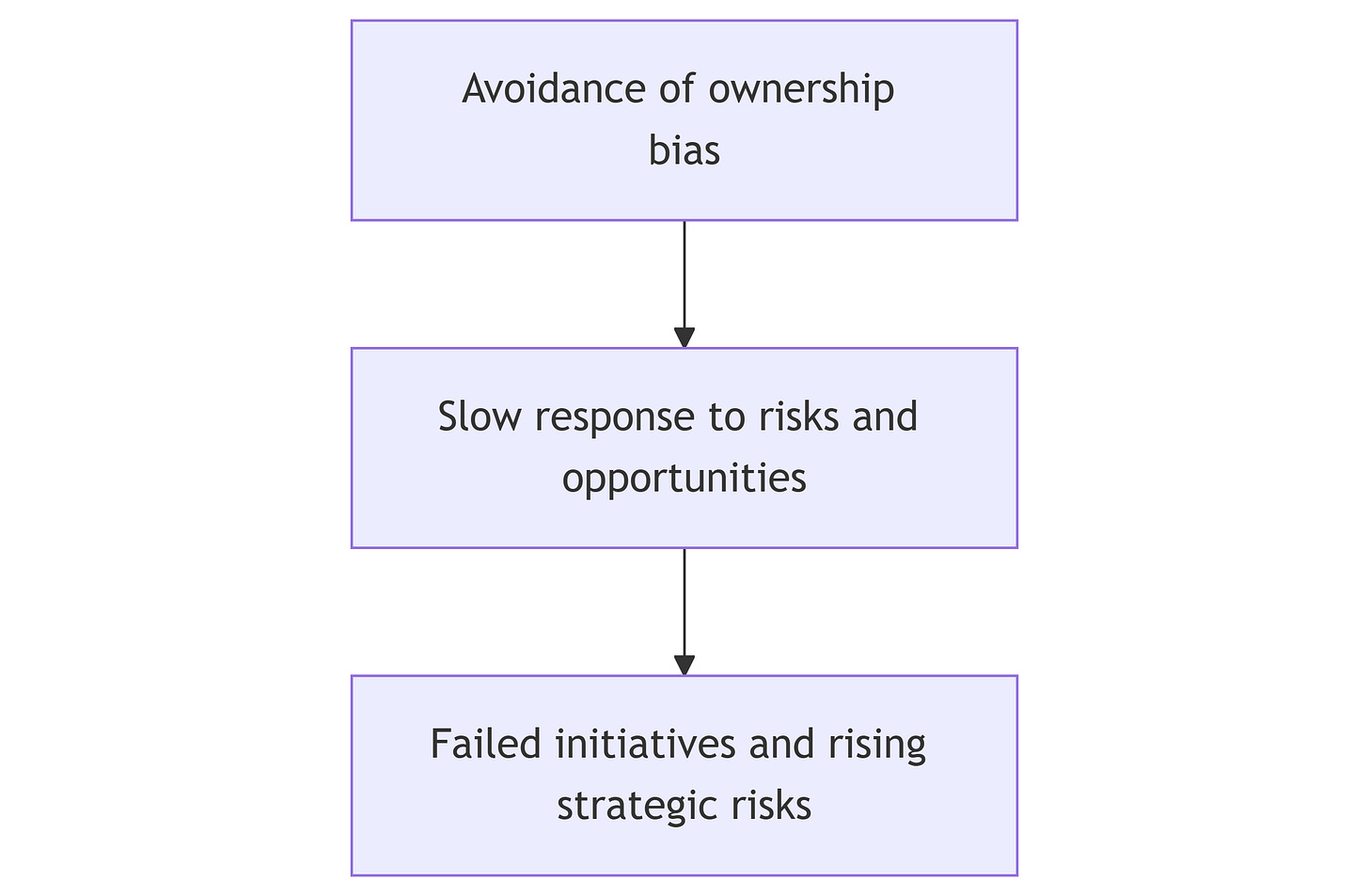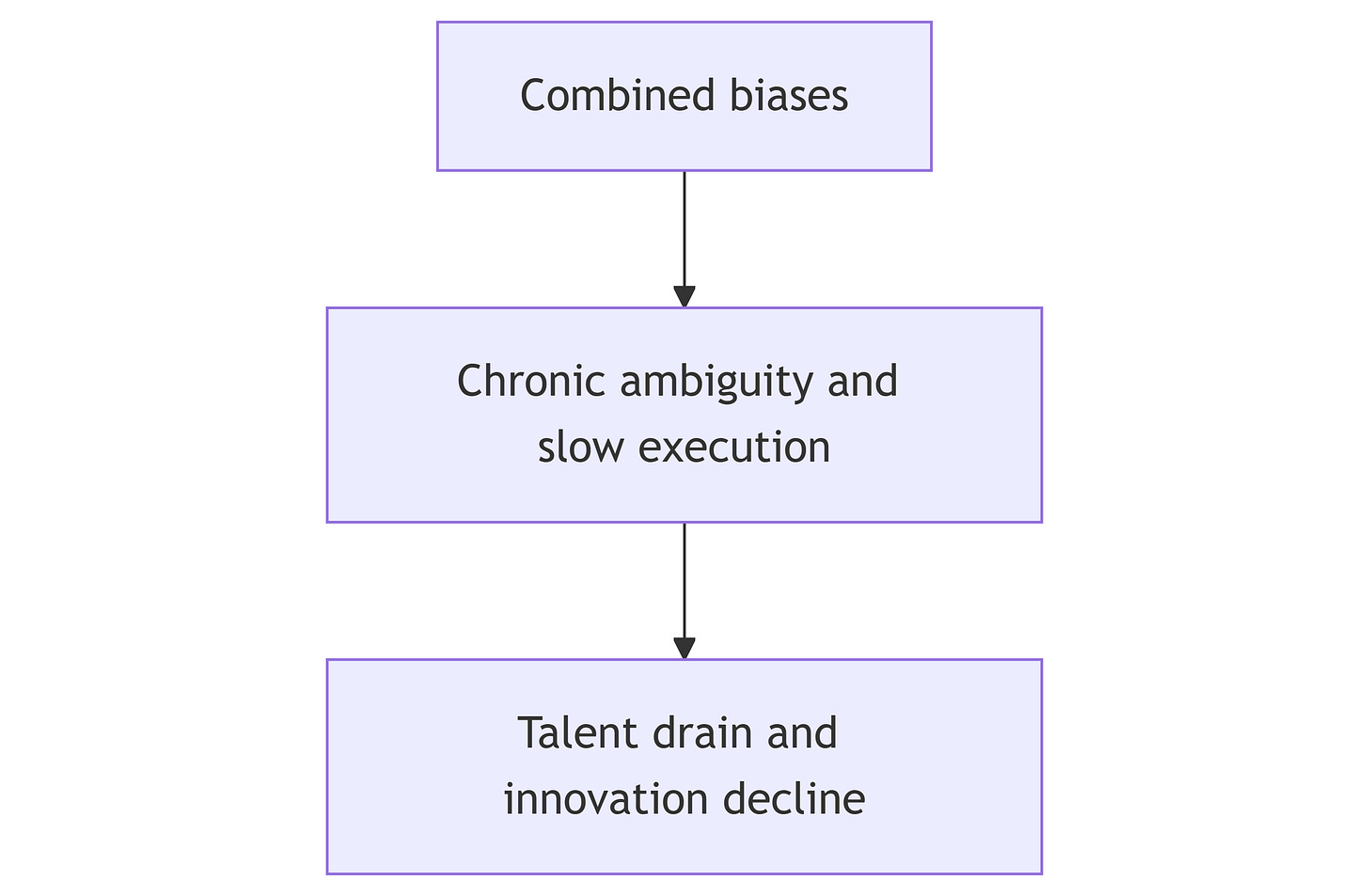The hidden leadership biases that sabotage true team autonomy
Autonomy is not just about letting teams "make their own decisions."
It is about providing the right support, setting clear boundaries, and assuming ownership at the right levels.
However, in many organizations today, especially those eager to be "modern" or "flat," two hidden cognitive biases creep in: delegation bias and avoidance of ownership bias.
These biases can erode team effectiveness, create frustration, and stall strategic progress.
In this article, we will break down these biases, how they appear day to day, their long-term costs, and what healthy leadership actually looks like.
Delegation bias
Delegation bias happens when leaders push the responsibility for important or complex decisions downward, often in the name of "empowerment," but without providing the necessary authority, clarity, or support.
On the surface, it looks positive:
"We trust you."
"You are empowered."
"Decide what you think is best."
But underneath, it often hides a deflection of real leadership responsibility.
Instead of supporting autonomy thoughtfully, leadership offloads critical decision-making to people who may not have the full context, the right influence, or the political protection to act effectively.
Why delegation bias happens
There are several drivers behind this pattern:
Fear of accountability: leaders avoid being blamed for difficult or controversial decisions.
Over-idealization of self-management: misunderstanding autonomy as "no leadership needed."
Desire to appear modern: adopting empowerment rhetoric without building real decision structures.
Emotional distance: delegating uncomfortable conversations, negotiations, or trade-offs to teams instead of handling them.
How it shows up day-to-day
You can usually spot delegation bias through subtle but harmful patterns:
Teams are asked to "figure it out" without clear success criteria or priorities.
Critical cross-team or cross-department conflicts are left unresolved, with teams expected to negotiate on their own.
Strategic dilemmas are pushed downward: "You all decide" when a clear choice and sponsorship are actually needed.
Leadership praises autonomy but avoids involvement when risks emerge.
The long-term impact of delegation bias
Over time, delegation bias produces serious organizational damage:
Paralysis: teams struggle to move forward when decisions require broader alignment or higher-level trade-offs.
False empowerment: teams are told they are autonomous, but they cannot make real systemic changes or get needed support.
Emotional exhaustion: teams feel abandoned, carrying emotional and political burdens they were never meant to.
Erosion of trust: teams begin to mistrust leadership's words about support and empowerment.
Avoidance of ownership bias
Avoidance of ownership bias happens when leaders or leadership structures systematically avoid owning difficult or risky problems, hoping others will either fix them or that they will somehow disappear.
While this bias is often subconscious, its effects are devastating:
Important decisions are delayed, ownership becomes ambiguous, and political tensions rise.
Why avoidance of ownership bias happens
It usually grows from:
Fear of failure: it feels safer to avoid committing to a decision than to risk being wrong.
Desire to stay "liked": avoiding hard decisions prevents upsetting any group or stakeholder.
Cultural habits: in organizations that reward diplomacy over clarity, avoidance behaviors can become normalized.
Overwhelm: leaders stretched too thin may unconsciously deflect ownership because they cannot handle one more responsibility.
How it shows up day-to-day
Typical signs of ownership avoidance include:
Leaders framing everything as "the team's decision" without offering clear framing, constraints, or support.
Proposals floating for months because no one will explicitly approve, reject, or prioritize them.
Organizational conflict being left unresolved under the belief that "the teams should work it out themselves."
Critical risks surfacing repeatedly without being formally addressed or mitigated.
The long-term impact of ownership avoidance
If avoidance of ownership bias is left unchecked, it creates:
Strategic drift: organizations lose sight of their priorities and focus.
Chronic misalignment: different teams pull in different directions without common leadership.
Burnout at lower levels: teams carry the psychological load of strategic ambiguity they were never equipped for.
Erosion of leadership credibility: eventually, people stop trusting leaders who do not act decisively.
The hidden cost of these biases on the business
These leadership biases do not just harm internal dynamics.
They directly impact business outcomes:
Ignoring these dynamics makes the organization slower, weaker, and more vulnerable to both internal collapse and external competition.
What healthy leadership for autonomy really looks like
Autonomy without leadership is abandonment.
Real autonomy requires healthy leadership behaviors like:
Providing framing: offering clear goals, boundaries, and priorities.
Owning system-level decisions: stepping up when a decision affects multiple domains or the whole organization.
Building negotiation structures: helping teams collaborate intentionally, not leaving them to fight alone.
Taking responsibility for trade-offs: accepting that some choices will upset people, and handling that tension thoughtfully.
Being present: not micromanaging, but staying close enough to detect when escalation or support is needed.
Final reflection
Building autonomous teams is not about getting rid of leadership.
It is about evolving leadership into something smarter, braver, and more disciplined.
If you truly want empowered teams, you cannot:
Push hard problems downward without support.
Expect teams to self-organize around systemic dysfunction.
Celebrate autonomy while dodging your own leadership responsibilities.
Instead, you must share leadership consciously:
Owning what only you can own.
Supporting what others should own.
Coaching teams to navigate their scope with clarity and confidence.
Autonomy and leadership are not opposites. They are partners. And together, they build the kind of organizations that can think, adapt, and thrive for the long haul.
Choose your leadership wisely.







